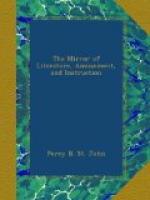(For the Mirror.)
A beautiful gold coin, a noble of the reign of Edward III., was discovered, some time since, by the workmen employed in excavating the river Witham, in the city of Lincoln. The coin is in excellent preservation. The impress represents the half-length figure of Edward in a ship, holding a sword in the right hand, and in the left a sceptre and shield, with the inscription “EDWARDUS DEI GRA. REX ANGL., DYS. HYB. ET AGT.” On the shield are the arms of England and France quarterly. On the reverse, a cross fleury with lionaux, inscribed, “JESVS AUTEM TRANSIENS PER MEDIUM ILLORUM IBAT.” These coins are very scarce, and remarkable as being the first impressed with the figure of a ship; this is said to have been done to commemorate the victory obtained by Edward over the French fleet off Sluys, on Midsummer-day, 1340, and which is supposed to have suggested to Edward the idea of claiming superiority over every other maritime power—a dominion which his successors have now maintained for nearly five hundred years. W.G.C.
* * * * *
PENDERELL JEWEL.
(For the Mirror.)
An ancient medal, or coin, ornamented with jewels, was purchased, a few years since, of one of the descendants of Penderell, to whom it was presented by Charles II., as a valuable token of his gratitude for certain protection afforded by him to that prince, when endeavouring to effect his escape in disguise from England, in the year 1648. It consists of a gold coin of Ferdinand II., dated 1638, surrounded by a row of sixteen brilliants enchased in silver, enriched with blue enamel, and bearing the motto, “Usque ad aris fidelis.” The reverse is also enameled, and the jewel is intended to be worn as an ornament to the person. W.G.C.
* * * * *
PECUNIARY COMPENSATION FOR PERSONAL INJURIES.
(For the Mirror.)
The present laws which enable a person to obtain pecuniary compensation for personal injuries, appear to be founded on very ancient precedent. Mr. Sharon Turner, in his History of the Anglo-Saxons, gives a statement of the sums at which our ancestors valued the various parts of their earthly tenements. He says “Homer is celebrated for discriminating the wounds of his heroes with anatomical precision. The Saxon legislators were not less anxious to distinguish between the different wounds to which the body is liable, and which from their laws, we infer that they frequently suffered. In their most ancient laws these were the punishments:
“The loss of an eye or of a leg, appears to have been considered as the most aggravated injury that could arise from an assault, and was therefore punished by the highest fine, or fifty shillings.
“To be made lame, was the next most considerable offence, and the compensation for it was thirty shillings.




